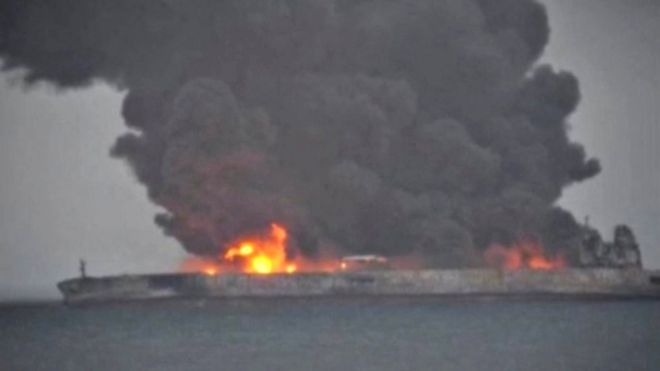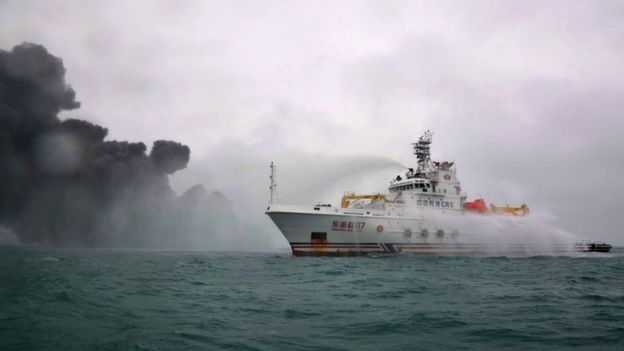 Courtesy of Reuters
Courtesy of Reuters
There are fears of an environmental disaster in the East China Sea as a tanker continues to leak oil two days after colliding with a cargo ship.
Chinese officials have told state media the Sanchi is in danger of exploding and sinking.
Rescuers attempting to reach the site were being beaten back by toxic clouds, the transportation ministry has said.
The body of one crewman, among the 30 Iranians and two Bangladeshis on board, has been found. The rest are missing.
- The spill Shetland survived
- Torrey Canyon: The day the sea turned black
- Is crude oil killing Nigeria's children?
- Exposure to oil sends birds off course
Where, how and when did the accident happen?
The Panama-flagged Sanchi was bringing its cargo of oil from Iran to South Korea when it collided with the Hong Kong-registered freighter CF Crystal, carrying grain from the US, in the East China Sea. The incident occurred about 260km (160 miles) off the coast of Shanghai.
The collision, in the mouth of the Yangtze River Delta, occurred on Saturday evening.
The exact cause of the collision is not yet known.
 |
| 4D3N ALL-IN MALAYSIA FUN & FANTASY PACKAGE |
What exactly is the Sanchi carrying?
The tanker, run by Iran's leading oil shipping operator, has on board 136,000 tonnes of condensate, which is an ultra light version of crude oil.
That's about one million barrels and at current prices is worth roughly $60m (£44m).
The Sanchi will also be carrying a certain amount of heavy - and toxic - shipping fuel.
Condensate is very different from the black crude that is often seen in oil spills.
It exists in gas form within high-pressure oil reservoirs and liquefies once extracted.
It is highly toxic, low in density and considerably more explosive than regular crude oil.
Condensate, which does not need the heavy refining process of denser crude, creates products such as jet fuel, petrol, diesel and heating fuel.

So is it bad for the environment?
Condensate is certainly very toxic. It remains liquid only under certain conditions.
John Driscoll of JTD Energy Services told the BBC: "Condensate is more likely to evaporate or mix in with the water.
"It also can be colour- and odour-less, so it is a lot harder to detect, contain and clean up."
The environmental impact of the spill may be mitigated by the distance of the collision from the nearest coastline and the fact lighter crudes can disperse more quickly.
But environmental expert Wei Xianghua told Agence France-Presse: "It's very possible this will kill off marine life across a wide area."
How is the rescue going?
The Sanchi was still ablaze on Monday morning.
Chinese foreign ministry spokesman Lu Kang said that weather conditions were "not that favourable for search and rescue work".
 AFP
AFP
There are no signs of survivors among the 32-strong crew, although the 21 Chinese nationals on the grain freighter were rescued.
China has sent several ships to carry out search-and-rescue operations, while South Korea helped with a coast guard ship and a helicopter.
The US Navy also sent a military aircraft to help with the rescue efforts.
How does this compare with other oil spills?
It's impossible to say at this point, because it's unknown how much oil has been, or will be, spilled.
The Sanchi's one million barrels is about 35 million gallons. Even if all of it spilled, it would be less than the major ship disasters listed below, but more than three times the Exxon Valdez spill in 1989, which is considered one of the world's worst environmental disasters.
So, how much the spill affects the environment depends on the location where it occurred. The Atlantic Empress incident listed below - the record spill from ships - saw little oil reach coastlines.
 AFP
AFP
There's also a lot of different types. Arguably the worst was the deliberate release of up to 500 million gallons by the Iraqis in January 1991 during the Gulf War. The resultant slick covered some 10,300 sq km (4,000 sq miles).
As far as ships are concerned:
- The Atlantic Empress and Aegean Captain collided off Trinidad and Tobago in 1979. The Atlantic Empress exploded and 26 crew members died. The 90 million gallon oil spill is a record from ships
- The ABT Summer exploded off Angola in 1991, spilling about 80 million gallons over 200 sq km
- The Castillo de Bellver caught fire and broke apart off Cape Town, spilling 78 million gallons
- The Amoco Cadiz spilled almost 69 million gallons after running aground off Brittany in France in 1978
- The Torrey Canyon hit a reef off Cornwall, England, in 1967, spilling 36 million gallons of crude and affecting almost 200 miles of coastline
- The Exxon Valdez only spilled 11 million gallons in Prince William Sound, Alaska, in 1989 but was a major environmental disaster

No comments:
Post a Comment